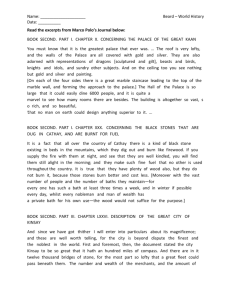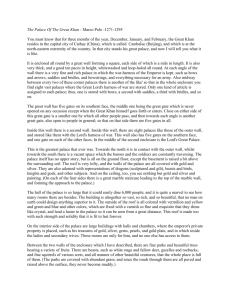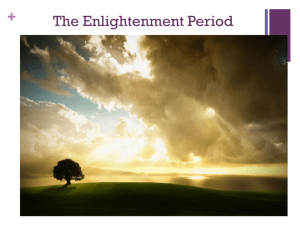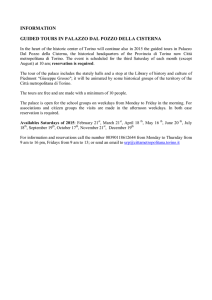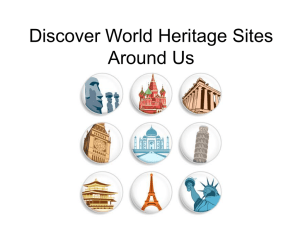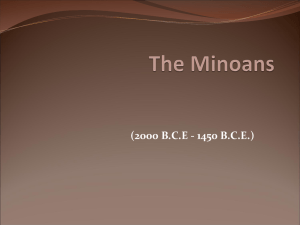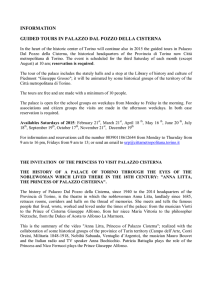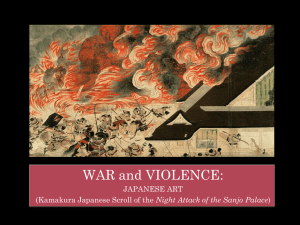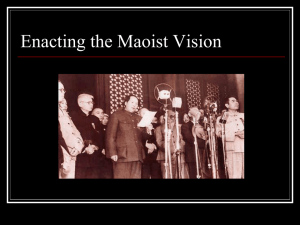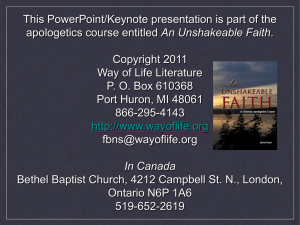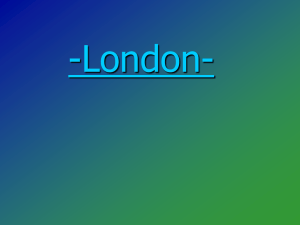Induction Day-History-Summer Work
advertisement
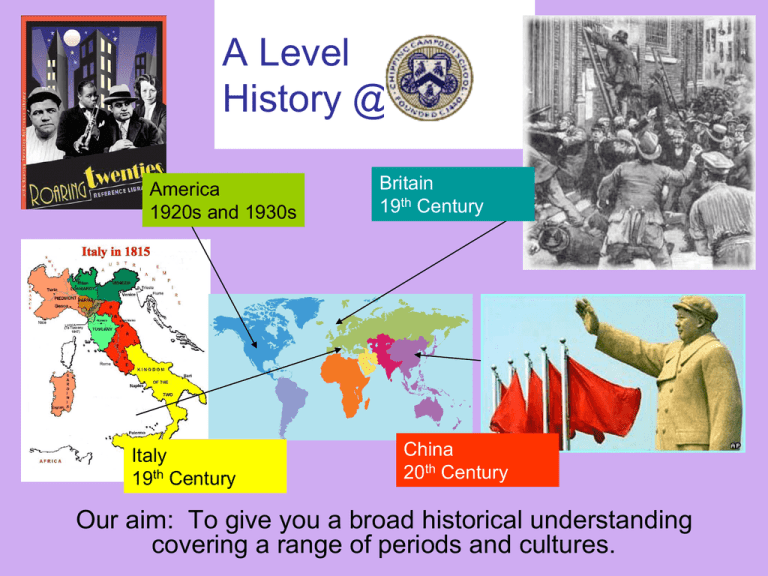
A Level History @ America 1920s and 1930s Italy 19th Century Britain 19th Century China 20th Century Our aim: To give you a broad historical understanding covering a range of periods and cultures. What do we study? Edexcel GCE History 9HI01 www.edexcel.com Unit Topic AS Method 1 6HI01 D 1 & 2 China 1900-1976 Historical Themes in Breadth Written exam 1 hr 20 Overall GCE 50% 25% 2 6HI02 B British History Depth Studies Written exam 1 hr 20 50% 25% Britain 1830-85: Representation and Reform Length A LEVEL 3 6HI03 C Depth Studies and Associated Controversies The United States, 1917-54: Boom, Bust and Recovery. Written exam 2 hours 60% 30% 4 6HI04 Historical Enquiry The Making of Modern Italy c. 1800- c. 1900 Coursework 4000 words maximum 40% 20% Unit 1 – Historical Themes in Breadth – China 1900-1976 (EK) •This unit concentrates on the development of Communism in China from 1900-1976. 1900-49: the overthrow of the old regime, revolution, civil war and the victory of Communism 1900-49. 1949-76: the development of the People’s Republic of China under Mao and its impact on people’s lives between the Communist victory in 1949 and Mao’s death in 1976. •We will look at the importance of ideas and beliefs in the policies developed in China and how and why these ideas are a cause of change and conflict. This unit will hopefully encourage pupils to debate the rights of citizens. Written Exam June 1 hour and 20 minute exam consisting of two essay questions. What do AS History Exams look like? China 2010 Britain 2010 Unit 2 – British History Depth Studies –Britain 1830-85: Representation and Reform (MH) Written Exam An element of British history is compulsory. We have chosen a topic June that has a profound impact on modern Britain. We will study the way in which people in 19th century Britain campaigned to gain their political rights through protest and organised pressure groups and the impact that this had on their everyday lives. We will also look at how this lead to the modern political parties that we have today in Britain. 1 hour and 20 minute exam consisting of two source based questions. Unit 3 – Depth Studies and Associated Controversies – The United States, 1917-54: Boom, Bust and Recovery. MH This unit encourages students to look at issues that have provoked disagreement and controversy amongst historians. The topic explores the roaring economy of America after the First World War, its demise in the Depression of the 1930s and the impact these changes had on the government and people, e.g. the development of organised crime (gangsters) and the Red (communist) Scare. There will also be an opportunity to look at key social tensions such as immigration, racism and the Ku Klux Klan. Written Exam June 2 hour exam consisting of one source based and one essay question. Unit 4 – Historical Enquiry – The Making of Modern Italy c. 1800- c. 1900 EK In this unit we will look at the process by which Italy became a united country. We will explore the long and short term causes and consequences of change and compare the significance of different factors e.g. the role of individuals such as Garibaldi, Mazzini or Napoleon III and the intervention of foreign countries such as France or Austria. Students will be taught a basic overview of events and then produce an independent enquiry supervised by Mrs Kingswood. This will require pupils to devise their own argument and collect research, including contemporary evidence to support it. COURSEWORK consisting of one source based and one essay question. Maximum 4000 words. What are lessons like? • • • • • • • • • • • • • Open forum Discussion Debate Role play Lecture style Group work Source Analysis Presentation ICT interactive games Research Card Sorting Essay planning Timed essay practice China Reading List Option D: A World Divided: Communism and Democracy in the 20th Century Topic D1: China, C1900-49 ``Fenby J — Generalissimo: Chiang Kai-shek and the China He Lost (Free Press, 2005) ``Lynch M — China: From Empire to People's Republic, 1900-49 (Hodder Murray, 1996) ``Mitter R — A Bitter Revolution: China's Struggle with the Modern World (Oxford University Press, 2005) 10 ``Roberts J A G — A History of China, Second Edition (Palgrave Macmillan, 2006) ``Schoppa R K — The Columbia Guide to Modern Chinese History (Columbia UP, 2000) Short P — Mao a Life (Hodder and Staughton1999,paperback John Murray, 2004) ``Spence J D —The Search for Modern China, Second Edition (W W Norton and Co Ltd, 1999) ``Stewart G — China 1900-1976 (Heinemann, 2006) Topic D2: China under Mao, 1949-76 ``Chang J and Halliday — J–Mao : The Unknown Story (Jonathan Cape, 2005) (incredible biased against Mao) ``Lynch M — The People’s Republic of China Since 1949 (Hodder Murray, 2008) ``Roberts J A G — A History of China, Second Edition (Palgrave Macmillan, 2006) ``Schoppa R K — The Columbia Guide to Modern Chinese History (Columbia UP 2000) Schram S R — The Political Thought of Mao Tse-Tung (Penguin, 1969) (1960s view…pro Mao) Short P — Mao a Life (John Murray, 2004) (quite balanced view) ``Spence J D — The Search for Modern China Second Edition (Norton, (2000) ``Stewart G — China 1900-1976 (Heinemann, 2006) ``Zhisui Li — The Private life of Chairman Mao (Chatto and Windus, 1994) Others for interest: Memoirs: Jung Chang – Wild Swans, Harper Collins 1991 (A Woman’s perspective) Gao Yuan – Born Red: A chronicle of the Cultural Revolution Cheng Nien – Life and Death in Shanghai, Grove Press 1986 Zhang Xianliang – Grass Soup, Secker and Warburg 1994. (Life in a Gluag) Zhisui Li — The Private life of Chairman Mao (Chatto and Windus, 1994 (His doctor’s view) Adeline Yenmah – A Thousand Pieces of Gold (the Past through Proverbs – very interesting) Gavin Menzies – 1421, the year that China Discovered the World. (Historically debatable!) I suggest getting a couple Of these books over the Holidays and having a Read. The books that are underlined are the texts I will provide you with. I look forward to seeing you in September! Unit 2 – British History Depth Studies –Britain 1830-85: Representation and Reform (MH) Recommended reading List A range of resources to give you some background on the topic. • George Eliot • Charles Dickens • • • • • Felix Holt Hard times A Tale of Two Cities. Elizabeth Gaskell North and South Cranford Biographies of Robert Peel and Lord Liverpool E.P.Thompson The Making Of the English Working Class ( 3 books in one - look at protest ) E.P.Thompson The Making Of the English Working Class ( 3 books in one - look at protest ) E Hobsbawm The Age of Empire. A FEAST OF ENTERTAINMENT! (From Mr Hobby) China vs Europe Marco…….Polo! Highlight extract. Marco Polo (c. 1254 – January 8, 1324) was a merchant from the Venetian Republic who wrote Il Milione, which introduced Europeans to China. He learned about trading whilst his father and uncle voyaged through Asia and met Kublai Khan.The three of them embarked on an epic journey to Asia, returning after 24 years. What impression do you get of Ancient China from Marco Polo’s account? What does it suggest about how developed China was by the 14th Century? From The Travels of Marco Polo (1271 – 1288) Cambaluc (Beijing) Concerning The Palace Of The Great Khan You must know that for three months of the year, December, January, and February, the Great Khan resides in the capital city of Cathay (China), which is called Cambaluc (Beijing), and which is at the north-eastern extremity of the country. In that city stands his great palace, and now I will tell you what it is like. It is enclosed all round by a great wall forming a square, each side of which is a mile in length. It is also very thick, and a good ten paces in height, whitewashed and loop-holed all round. At each angle of the wall there is a very fine and rich palace in which the war-harness of the Emperor is kept, such as bows and arrows, saddles and bridles, and bowstrings, and everything necessary for an army. Also midway between every two of these corner palaces there is another of the like' so that in the whole enclosure you find eight vast palaces where the Great Lord's harness of war are stored. Only one kind of article is assigned to each palace; thus, one is stored with bows, a second with saddles, a third with bridles, and so on. The great wall has five gates on its southern face, the middle one being the great gate which is never opened on any occasion except when the Great Khan himself goes forth or enters. Close on either side of this great gate is a smaller one by which all other people pass; and then towards each angle is another great gate, also open to people in general; so that on that side there are five gates in all. Inside this wall there is a second wall. Inside this wall, there are eight palaces like those of the outer wall, and stored like them with the Lord's harness of war. This wall also has five gates on the southern face, and one gate on each of the other faces. In the middle of the second enclosure is the Lord's Great Palace. This is the greatest palace that ever was. Towards the north it is in contact with the outer wall, whilst towards the south there is a vacant space which the barons and the soldiers are constantly traversing. The palace itself has no upper story, but is all on the ground floor, except the basement is raised a bit above the surrounding soil. The roof is very lofty, and the walls of the palace are all covered with gold and silver. They are also adorned with representations of dragons (sculptured and gilt), beasts and birds, knights and gods, and other subjects. And on the ceiling, too, you see nothing but gold and silver and painting. (On each of the four sides there is a great marble staircase leading to the top of the marble wall, and forming the approach to the palace.) The hall of the palace is so large that it could easily dine 6,000 people; and it is quite a marvel to see how many rooms there are besides. The building is altogether so vast, so rich, and so beautiful, that no man on earth could design anything superior to it. The outside of the roof is all colored with vermilion and yellow and green and blue and other colors, which are fixed with a varnish so fine and exquisite that they shine like crystal, and lend a luster to the palace so it can be seen from a great distance. This roof is made too with such strength and solidity that it is fit to last forever. On the interior side of the palace are large buildings with halls and chambers, where the emperor's private property is placed, such as his treasures of gold, silver, gems, pearls, and gold plate, and in which reside the ladies and secondary wives. These rooms are only for him, and no one else has access to them. Between the two walls of the enclosure which I have described, there are fine parks and beautiful trees bearing a variety of fruits. There are beasts, such as white stags and fallow deer, gazelles and roebucks, and fine squirrels of various sorts, and all manner of other beautiful creatures, that the whole place is full of them. (The parks are covered with abundant grass; and since the roads through them are all paved and raised above the surface, they never become muddy.) To the northwest there extends a fine lake, containing fish of different kinds which the emperor ordered put in there, so that whenever he desires any he can have them. A river enters this lake and flows from it, but there is a grating of iron or brass put up so that the fish cannot escape. On the north side of the palace, there is a hill which has been made (from the earth dug out of the lake). It is a good hundred paces in height and a mile in compass. This hill is entirely covered with trees that never lose their leaves, but remain ever green. And I assure you that wherever a beautiful tree may exist, and the emperor gets news of it, he sends for it and has it transported with all its roots and the earth attached to them, and planted on that hill of his. No matter how big the tree may be, he gets it carried by his elephants; and in this way he has got together the most beautiful collection of trees in the whole world. He has also ordered the whole hill to be covered with green stones. Thus not only are the trees all green, but the hill itself is all green likewise; and there is nothing to be seen on it that is not green; and hence it is rightly called the Green Mount. On top of the hill there is another fine big palace which is all green inside and out. Thus, the hill, the trees, and the palace form together a charming spectacle. It is marvelous to see them. Everybody who sees them is delighted. The Great Khan built this beautiful prospect for the comfort and solace and enjoyment of his heart. China vs Europe 3. What was going on in Europe at the time? How do they compare? Why are there differences? China vs Europe Summer Homework 1. RESEARCH A) Draw a brief timeline of Chinese History from 2200BC – c. 1900AD. Label Dynasties and key events. (Use photocopied readings Lynch P 1-6 and Stewart P 3 -10 – see EK) Label China above the line only. Leave space below for question (B). Remember a timeline is like a graph, space years evenly to aid analysis. B) Find a timeline of key events in European History (Good ole Google??) Label European events below the line. 2. ANALYSIS How do they compare? Any surprises? Try to account for differences. When does China start to ‘lag behind’ Europe? Any idea why? Please bring to our first lesson! Any issues email ek@chippingcampden.gloucs.sch.uk
